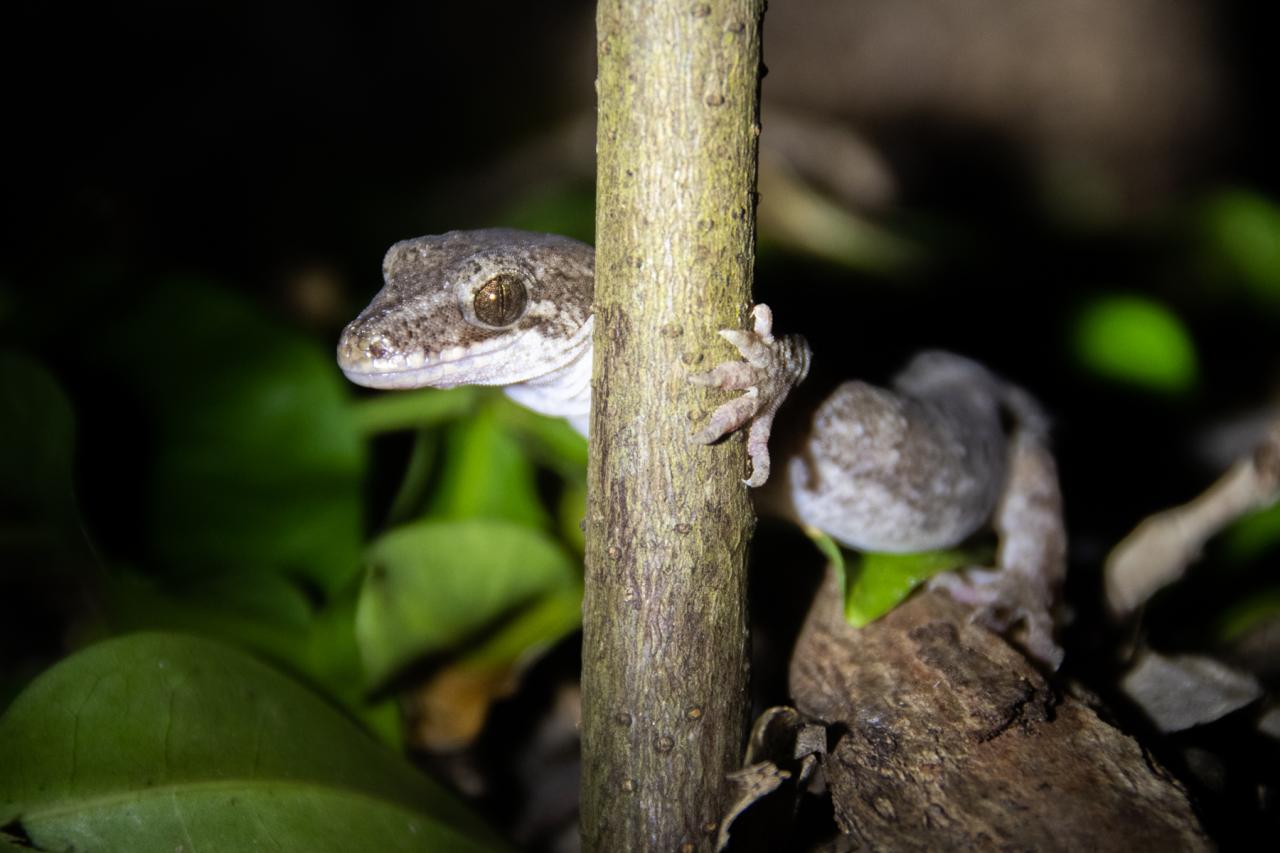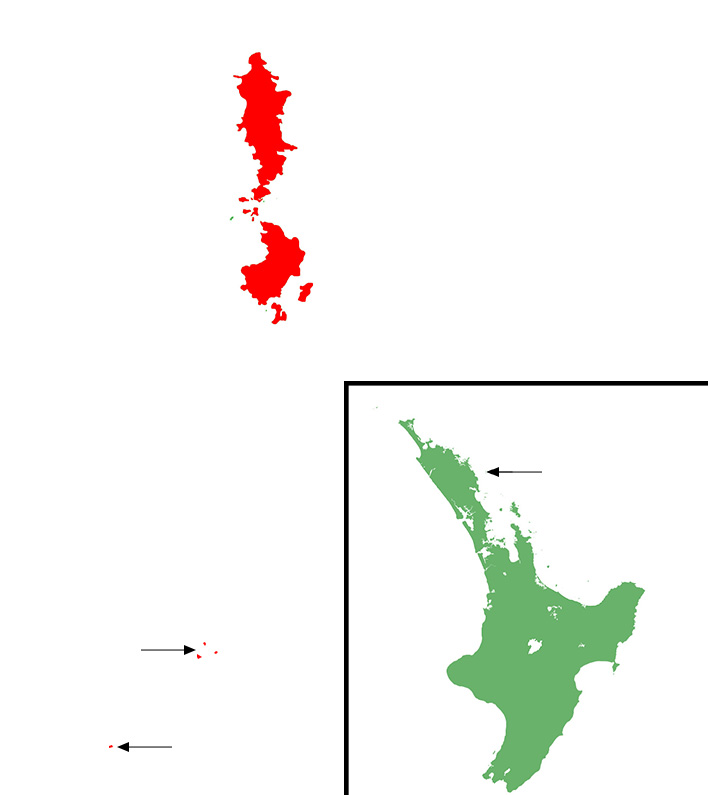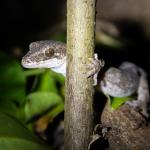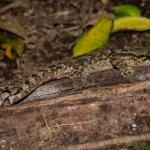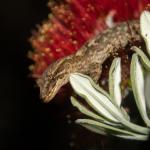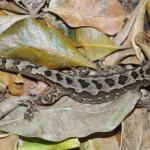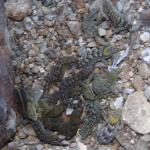- Home
- Herpetofauna Index
- Native
- Dactylocnemis "Poor Knights"
Dactylocnemis "Poor Knights"
Poor Knights gecko
Dactylocnemis "Poor Knights"
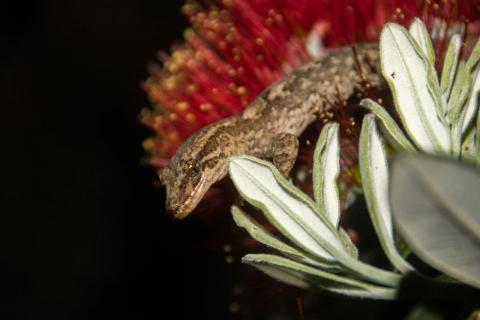
Length: SVL up to 95mm, with the tail being equal to or longer than the body length
Weight: unknown
Description
Poor Knights geckos are an island-endemic member of the genus Dactylocnemis found only on the Poor Knights Islands off eastern Northland.
Poor Knights geckos are large, robust in build, and highly variable in colour / pattern. Dorsal surface may be grey, brown, or olive in colour and variously patterned with blotches, chevrons, stripes or combinations of these. patterns may be drab / indictinct, or prominent and edged with white or black borders.The dorsal surface of the tail is covered with a series of light coloured blotches. Lateral surfaces often lighter in colour with have pale / indistinct speckling. On the head, the rostral scale is in broad contact with the nostril, and there is often a mustard-yellow coloured mark on the nape of the neck. Additional yellow blotches may be present over the rest of the body and tail. Ventral surface (belly) is cream and usually unmarked, sometimes with yellow blotches.
Poor Knights geckos may be confused with the sympatric Duvacel's gecko (Hoplodactylus duvaucelii), but can be distinguished by their much smaller adult size and generally lower lamellae counts on the 4th toe of the hind-foot (geckos with over 16 lamellae will be H. duvaucelii).
Very similar in appearance to other members of the Dactylocnemis genus, but geographically isolated.
Life expectancy
Unknown
Distribution
Poor Knights geckos are endemic to the Poor Knights Archipelago and two isolated rock stacks to the south of them (High Peak Rocks, and Sugarloaf Rock). This species evolved on these islands and has never been found anywhere else.
Ecology and habitat
Poor Knights geckos are primarily nocturnal, but have also been known to cryptically sun-bask at the entrance of retreat sites (e.g rock crevices). Some populations on rock stacks (e.g. Sugarloaf Rock) are cathemeral or primarily diurnal. They are habitat generalists and may be arboreal of terrestrial.
Poor Knights geckos can be found in forest, scrub, flaxland, dense prostrate vegetation (such as Muehlenbeckia sp.), rock piles and on cliffs. When not active they take refuge in rock crevices, dense vegetation tree hollows, or under rocks, logs and loose bark on trees.
Social structure
Poor Knights geckos occur at high densities, and can regularly be found sharing retreat sites with conspecifics (other individuals of the same species).
Breeding biology
The reproductive biology of Poor Knights geckos is poorly known.
Diet
Poor Knights geckos are omnivorous. They have been recorded feeding on a wide range of invertebrates (insects, spiders, isopods etc.), as well as nectar and fruit / berries from native plants. Unusually for a gecko, some populations on rock stacks (e.g. Sugarloaf Rock) are known to feed on regurgitated fish in seabird colonies when adults birds are feeding their chicks and pieces fall to the ground.
Disease
Largely unknown, however, is known to be a host for at least two ectoparasitic mites - Geckobia haplodactyli, and an unidentified species of the Ophionyssus genus.
Conservation strategy
Poor Knights geckos are endemic to the Poor Knights Islands, and occupy their entire historical range. These islands are pest-free, and as such the main threat to these geckos is from the introduction of mammalian predators to their island refuges.
The Poor Knights islands are a protected Nature Reserve, landing is prohibited without a permit from the Department of Conservation, and strict biosecurity measures are adhered to for all island visitors.
Interesting notes
The Poor Knights gecko gets both its common and TAG names from the Poor Knights Islands - the only locality for this species in Aotearoa.
Poor Knights geckos are members of the genus Dactylocnemis, a group of closely related species which are confined to the North Island of New Zealand, are regionally distributed (including several island-endemic species), and were once all considered as a single highly-variable species - Hoplodactylus pacificus.
The Poor Knights gecko belongs to the "southern clade" within the Dactylocnemis genus, with its sister taxa being the Pacific gecko, and Mokohinau gecko. The Matapia gecko also sits within this group but is more distantly related.
References
Hitchmough, R.A., Barr, B., Lettink, M., Monks, J., Reardon, J., Tocher, M., van Winkel, D., Rolfe, J. (2016). Conservation status of New Zealand reptiles, 2015; New Zealand threat classification series 17. Wellington: New Zealand Department of Conservation.
Jewell, T. (2011). A photographic guide to reptiles and amphibians of New Zealand. Auckland: New Holland Publishing.
van Winkel, D., Baling, M. & Hitchmough, R. (2018). Reptiles and Amphibians of New Zealand: A field guide. Auckland: Auckland University Press, 376 pp.
Whitaker, A. H. (1968). The lizards of the Poor Knights Islands, New Zealand. New Zealand journal of science, 11, 623-651.

